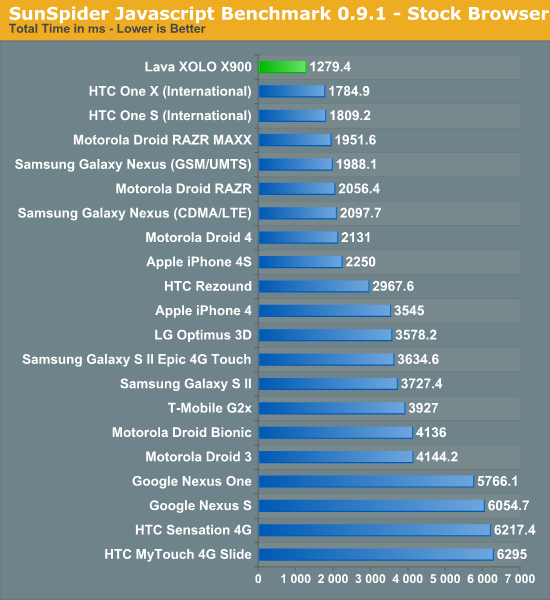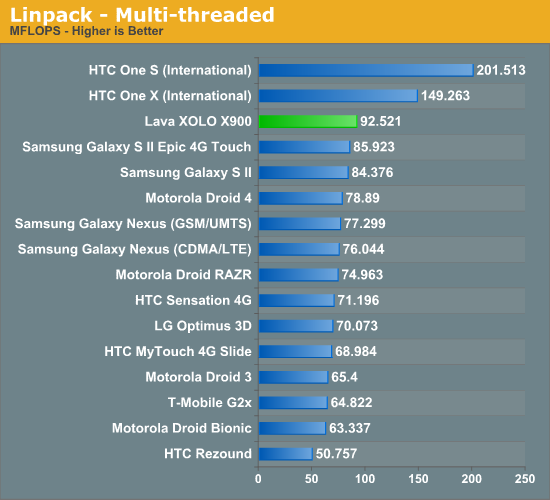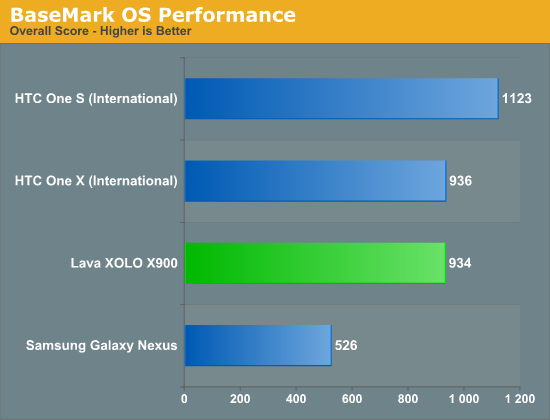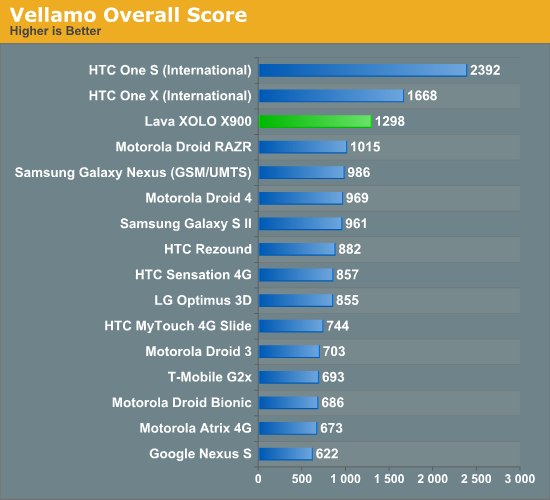Lava Xolo X900 Review - The First Intel Medfield Phone
by Brian Klug on April 25, 2012 6:00 AM ESTJavascript Performance
Although smartphones are clearly headed for a life beyond simple messaging, web browsing and phone duties, we are still lacking the tools to measure performance in areas other than a component of web page rendering. Measuring javascript performance is one component of the entire web page rendering process but it's the most mature in terms of something we can benchmark.
Sunspider is quite possibly the most well known of these javascript tests, and it also happens to be one that runs extremely well on Medfield:

The Lava phone is just a tad faster than the FFRD we tested at the beginning of the year, which may not sound like much but is positive given that Mike Bell was very confident that all Intel FFRD phones would deliver the same level of performance. The X900 ends up being the fastest smartphone we've ever tested here. Intel won't be able to claim that title in any other benchmark here today but it's an impressive feat for just now showing up to the game. It's also worth pointing out that Intel is able to do this well running on Gingerbread, while its closest competition are running on Ice Cream Sandwich with far improved JS performance built into the browser.
Why is Medfield so much faster here? It's tough to say, but likely a combination of reasons. Google's V8 engine has had a ton of optimization work done around x86 to begin with. By virtue of nearly every computing platform that runs a Google browser outside of Android being x86, it's natural that some of those optimizations are going to transition over into Android for x86 as well. That's actually a part of a much larger advantage Intel has should x86 take off in the smartphone space.
On a more technical hardware level, Intel claims its cache and memory interfaces are simply better than the competition here - which in turn results in a significant performance jump in Sunspider.
BrowserMark is another js benchmark in our suite, but here the advantage has been reduced to simply competitive with the fastest phones in our labs:

For a single Atom core running Gingerbread, Medfield does very well here - roughly equaling the performance of NVIDIA's Tegra 3 (HTC One X) and Qualcomm's Snapdragon S4 (HTC One S). It's quite possible that when running ICS Medfield will once again step ahead of the competition, but even if this is as good as it gets it's a good start. Keep in mind that we're looking at a 4 year old microprocessor architecture running on a n - 1 process from Intel.
Low Level FP Performance
Linpack isn't a great indication of smartphone performance, but it is a good test of the floating point capabilities of the CPUs in these SoCs. ARM has steadily been improving FP performance for the past few generations but we're going to see a big jump to Krait/A15. As most client smartphone workloads are integer based and those that are FP heavy end up relying on the GPU, an advantage here doesn't tell us much today (particularly because Linpack isn't running native code but rather atop Dalvik) other than how speedy the FPUs are:

Single threaded FP performance is very good on Medfield as you'd expect, but a bit lower than Qualcomm's Snapdragon S4. As Krait is a wider, out-of-order architecture with a fairly reasonable FPU the 13% advantage here isn't too surprising. Compared to anything A9 based however, Medfield is obviously quicker.
Linpack, like many scientific workloads, scales up to multiple cores quite nicely. If we spawn as many threads as there are logical cores (2 for Intel and Qualcomm, but 4 for NVIDIA's Tegra 3) we can see how Intel's single-core Atom fares in a multithreaded world:

There's roughly no change in Medfield's performance here, which will be an issue for any compute heavy, very threaded application. Luckily for Intel, not many of these types of applications exist on smartphones today, but it is a limitation of this first generation Medfield. Hyper Threading is a great way to increase CPU utilization power efficiently, but for some workloads there's no replacement for more cores. Snapdragon S4 does extremely well here in the HTC One S by being a combination of two cores and having a much faster FPU.
BaseMark OS
Rightware's BaseMark OS is a general purpose benchmark designed to better simulate overall Android performance. It includes a heavily threaded benchmark, file IO tests, and compression/decompression tasks that all contribute to its overall score. We only have results from the HTC One S (Snapdragon S4), One X (Tegra 3), Galaxy Nexus (OMAP 4) and the Lava phone (Medfield) here:

At least in BaseMark OS, Intel's performance is distinctly modern although not at the head of the class. Differences in performance here extend beyond the SoC and are obviously influenced by things like NAND selection as well as the OS on the device. For many of these benchmarks I'm very curious to see how they change with the arrival of Ice Cream Sandwich.
Vellamo
Vellamo is a Qualcomm developed benchmark that focuses primarily on browser performance, both in rendering and UI speed. The results are heavily influenced by the browser used on the device being tested. As a whole Vellamo isn't always indicative of whether or not you're going to get a smooth browsing experience, but it's another datapoint that captures more than just javascript performance. The Qualcomm-developed nature of the benchmark is always cause for concern, but even if you exclude the Snapdragon results the benchmark can be useful:

Once again we have a good showing from Intel. The X900 and its Medfield soul aren't the fastest, but Intel's first smartphone is in the top three and faster than almost everything that came before it. Much of the advantage here actually comes from the Google V8 benchmark, another js test, which we've already established Intel can do quite well in.
Flash Rendering Performance
These days nearly all high-end smartphones (I refuse to call them superphones) can render Flash smoothly. Thankfully Intel's platform is no exception as the X900 delivers a competitive showing in our Flash benchmark:











106 Comments
View All Comments
Splynn - Sunday, April 29, 2012 - link
I'm curious as to if there will be cost saving in the software development side of a tablet or phone. Intel is very good at developing platforms at this point that have a consistency from a software point of view (for example, PCIe works like a super set of PCI from a software point of view which was a big factor in its adoption).If this saves enough on the cost of development and maintaining the software, then it would seem to be a good option. But it would be a new way of doing business for the embedded market.
djgandy - Wednesday, April 25, 2012 - link
Not a bad attempt, sure there are better SoC's out there but considering the age of the current Atom architecture and how it began it's not faring too badly. Medfield is a pretty old chip in terms of design. I'd expect Intel to start tick-tocking with Atom soonname99 - Thursday, April 26, 2012 - link
The whole POINT is that Intel probably can't spin this as fast as ARM can. That has always been the more intelligent argument against Intel in this space-not that x86 is too large or too power hungry, but that it is so so so much more painful to design and validate, but any attempt to cut corners has the potential for embarrassing bugs like the pentium FPU bug.therealnickdanger - Wednesday, April 25, 2012 - link
I wonder how much better this phone would do with ICS loaded instead of GB? Will AT give this phone an update when the official ROM is released?Please forgive my ignorance - you could load Windows XP or Windows 7 on this thing, correct? Dual boot? Is there hardware that would restrict one from doing so? Seems to me that if it's just a glorified X86 Atom, it could be done. Arguments about drivers, battery life, and overall functionality aside...
I'll keep watch over at XDA...
S20802 - Wednesday, April 25, 2012 - link
How would it be with Win7 SE? Pretty Cool for fun.Rick83 - Wednesday, April 25, 2012 - link
There might be some issues with Windows, as it probably expects some desktop hardware, such as PCI or PCIe buses.While the CPU is x86 (x64 supposedly), the systems is not necessarily what you'd call "PC-compatible".
Plus, the boot-loader is probably locked tightly.
It would be interesting to see how Windows 8 positions itself though. With the mobile version now being called Windows for ARM, I'm wondering if the normal version will run on the reduced platform that mobile Atom offers.
superPC - Wednesday, April 25, 2012 - link
Windows 8 can run on x86 SOC with LPDDR2 and no PCI/PCIe buses ( http://phil-it.org/chris/?p=1179 ). This phone can't run windows 8 though because it doesn't have any DirectX 9_3 compatible GPU. Now if anyone started selling phones with Z2580 (it uses PowerVR SGX544MP2 that can run DirectX 9_3) than it's all fair game (provided we can tinker with the BIOS and bootloader).IcePhase - Wednesday, April 25, 2012 - link
Doesn't Windows 8 also require a 768p screen?superPC - Wednesday, April 25, 2012 - link
yes if you want to run metro apps. if you only use the desktop than it's all good (tried this myself with HP mini note with the exact same resolution as this phone, pathetic i know...). for benchmarking though desktop is all we need. if you want to use it as a phone though than it's going to be tough (to say the least).superPC - Wednesday, April 25, 2012 - link
yes if you want to run metro apps. if you only use the desktop than it's all good (tried this myself with HP mini note with the exact same resolution as this phone, pathetic i know...). for benchmarking though desktop is all we need. if you want to use it as a phone though than it's going to be tough (to say the least).